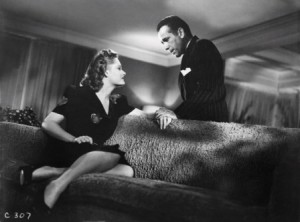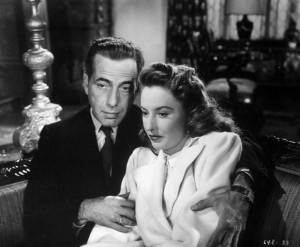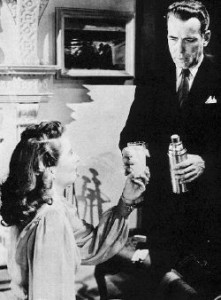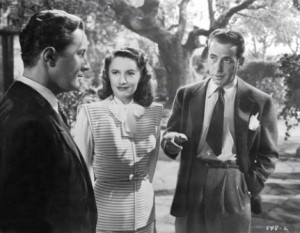 Once in the house, it’s confirmed what has been suggested in the garden, that Cecily is coming on to Geoffrey—and even earlier, twice in the village, she says, when he apparently ignored her. There’s a rather ineptly handled, almost superfluous race track scene, though it does show the growing relationship between Geoffrey and Cecily—now holding hands—and the return of the chemist Blagdon (Barry Bernard), who had appeared earlier outside the house. Blagdon is blackmailing Geoffrey because of that earlier purchase of what, presumably, was poison—it’s not made clear.
Once in the house, it’s confirmed what has been suggested in the garden, that Cecily is coming on to Geoffrey—and even earlier, twice in the village, she says, when he apparently ignored her. There’s a rather ineptly handled, almost superfluous race track scene, though it does show the growing relationship between Geoffrey and Cecily—now holding hands—and the return of the chemist Blagdon (Barry Bernard), who had appeared earlier outside the house. Blagdon is blackmailing Geoffrey because of that earlier purchase of what, presumably, was poison—it’s not made clear.
A Doctor Tuttle has arrived to treat Sally, who by now, coincidental with the arrival of Geoffrey’s latest female inspiration, is suffering from fatigue and severe headaches. The good doctor is played by Nigel Bruce, forgetting he isn’t Dr. Watson in one of the Sherlock Holmes/Basil Rathbone films; the last five of these mysteries were being made in 1945 and ’46, concurrently with The Two Mrs. Carrolls. Nigel Bruce blithely continues his Dr. Watson impression, with the lower head, looking up from under his brows, the under breath mumblings, double takes and a dotty, shambling manner, much as he also did in Rebecca and Suspicion.
As a physician, too, he’s as droll and unperceptive as that other doctor, suggesting that Sally is merely suffering from “nerves,” and that Geoffrey should continue his regimen of calming glasses of . . . milk.
 Soon Geoffrey is painting Cecily’s portrait, she’s calling him “darling” and they are kissing while the wife suffers in bed upstairs. Cecily doesn’t like the status quo and, unable to have him all to herself, she plans to leave on a trip. He becomes angry, says she’s not to go and gets that crazy look in his eyes which has appeared several times before. The wild-eyed stare and the bearing-of-the-teeth grimace, with fingertips to the lower lip, should look familiar: they will be used more effectively almost ten years later in a good movie, The Caine Mutiny. Geoffrey is traumatized when he hears church bells and when Bea mentions the mental problems of painter Vincent van Gogh—opportunities for some of Humphrey Bogart’s worst acting.
Soon Geoffrey is painting Cecily’s portrait, she’s calling him “darling” and they are kissing while the wife suffers in bed upstairs. Cecily doesn’t like the status quo and, unable to have him all to herself, she plans to leave on a trip. He becomes angry, says she’s not to go and gets that crazy look in his eyes which has appeared several times before. The wild-eyed stare and the bearing-of-the-teeth grimace, with fingertips to the lower lip, should look familiar: they will be used more effectively almost ten years later in a good movie, The Caine Mutiny. Geoffrey is traumatized when he hears church bells and when Bea mentions the mental problems of painter Vincent van Gogh—opportunities for some of Humphrey Bogart’s worst acting.
When Bea and Dr. Tuttle, on separate occasions, inquire about a portrait Geoffrey is painting of Sally, he replies that she doesn’t know about it, that he’s working only from sketches, that no one is to see it until he’s finished. Hum-m-m—— And having gotten one of those phone calls from Blagdon, he departs for London to make another payment and ends up killing the man.
And what about poor Sally? Things are going from bad to worse. In a sudden flurry of revelations, she realizes her precarious situation, and Stanwyck is quite good in traversing the five stages of discovering her husband is a wife murderer—disbelief, shock, distress, remorse and—no, not acceptance—resolution. Most of the disclosures come from Bea and the maid Christine (Anita Bolster).
First, Sally has found on the floor a Victor Hugo rose, which Cecily always wears. There are those numerous unexplained phone calls from London. Sally learns, too, Geoffrey’s wife was not an invalid, as he had told her, and that she died soon after his return from Scotland—and after finishing “The Angel of Death.” And now he’s working on a portrait of Sally no one can see. Geoffrey always brought the first Mrs. Carroll milk. And Blagdon is a chemist, not associated with the school where Geoffrey is sending Bea, who smugly observes, “What does a chemist know about schools?” But otherwise she can’t, it seems, put two and two together.
 For better or worse, the dénouement arrives—long and drawn out, complete with a thunderstorm (naturally) and milk on the windowsill, spilled when Sally disposed of the latest glass of the drink. There’s much running around and struggles over a gun, even a homage (intentional?) to Dracula when Geoffrey enters through a window, throwing back the drapes, arms outstretched, eyes glaring. That last, even in this foolish context, is too much. Oh, and there’s Franz Waxman’s music to underline, emphasize, dramatize and cause serious inner ear damage; Warner Bros. at the time was known for louder background music than other studios, but this is ridiculous! Maybe something to do with the restoration of the 2010 DVD release.
For better or worse, the dénouement arrives—long and drawn out, complete with a thunderstorm (naturally) and milk on the windowsill, spilled when Sally disposed of the latest glass of the drink. There’s much running around and struggles over a gun, even a homage (intentional?) to Dracula when Geoffrey enters through a window, throwing back the drapes, arms outstretched, eyes glaring. That last, even in this foolish context, is too much. Oh, and there’s Franz Waxman’s music to underline, emphasize, dramatize and cause serious inner ear damage; Warner Bros. at the time was known for louder background music than other studios, but this is ridiculous! Maybe something to do with the restoration of the 2010 DVD release.
 The film’s outcome is left for the viewer to discover. Perhaps—surely!—the results are obvious. There is an unnecessary attempt at a subplot, about burglars and a “Yorkshire strangler,” that only causes confusion. Alexis Smith seems rigid, with an impassive face, much like Lana Turner’s on occasions, and her love scenes with Humphrey Bogart are perfunctory. There is absolutely no chemistry between them. In one kiss, the camera records only the backs of their heads.
The film’s outcome is left for the viewer to discover. Perhaps—surely!—the results are obvious. There is an unnecessary attempt at a subplot, about burglars and a “Yorkshire strangler,” that only causes confusion. Alexis Smith seems rigid, with an impassive face, much like Lana Turner’s on occasions, and her love scenes with Humphrey Bogart are perfunctory. There is absolutely no chemistry between them. In one kiss, the camera records only the backs of their heads.
I really enjoyed your review! Very amusing 🙂
I actually didn’t mind the movie too much the few times I’ve seen it, but your review did point out why several things were very very silly.
I like all the actors in this movie, I didn’t think Barbara Stanwyck did such a bad job, and Alexis Smith was easy to hate (as always). I do think someone like Errol Flynn…or anyone else would have been better suited for Humphry Bogart’s role. In a way, I think this movie and “Cry Wolf” (another Barbara Stanwyck movie) are pretty similar. Cry Wolf is better though I think.
Very good film…did not care about the bad writing…enjoyed it Very good cast and high camp